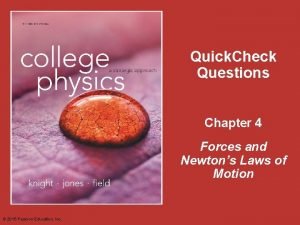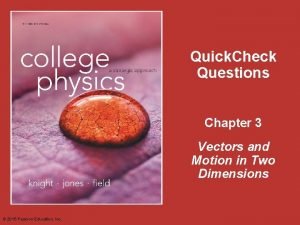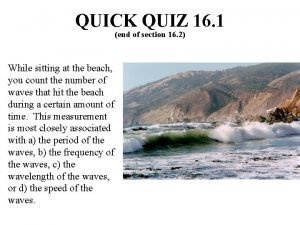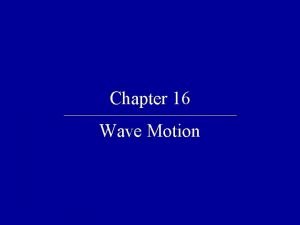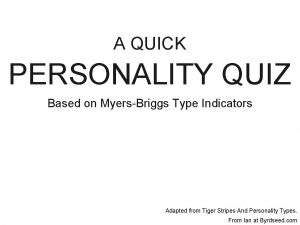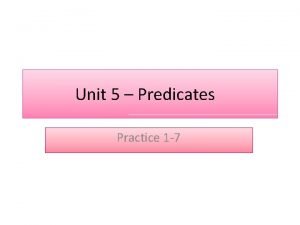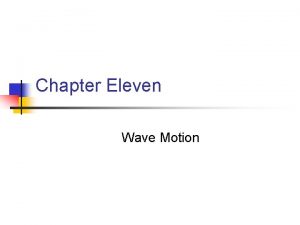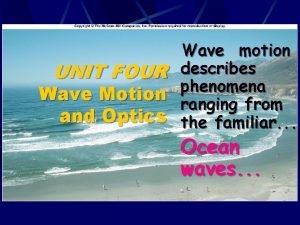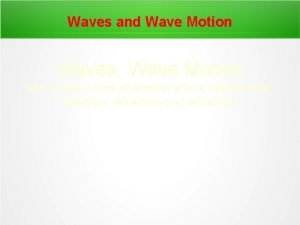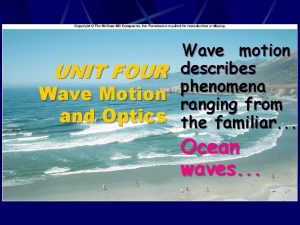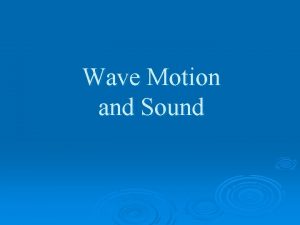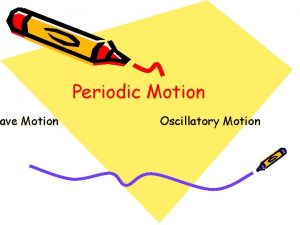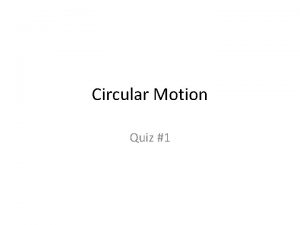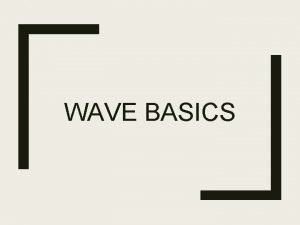Chapter 16 Wave Motion Quick Quiz 16 1

















- Slides: 17

Chapter 16 Wave Motion

Quick Quiz 16. 1 In a long line of people waiting to buy tickets, the first person leaves and a pulse of motion occurs as people step forward to fill the gap. As each person steps forward, the gap moves through the line. The propagation of this gap is (a) transverse (b) longitudinal

Quick Quiz 16. 1 Answer: (b). It is longitudinal because the disturbance (the shift of position of the people) is parallel to the direction in which the wave travels.

Quick Quiz 16. 2 Consider the “wave” at a baseball game: people stand up and shout as the wave arrives at their location, and the resultant pulse moves around the stadium. This wave is (a) transverse (b) longitudinal

Quick Quiz 16. 2 Answer: (a). It is transverse because the people stand up and sit down (vertical motion), whereas the wave moves either to the left or to the right.

Quick Quiz 16. 3 A sinusoidal wave of frequency f is traveling along a stretched string. The string is brought to rest, and a second traveling wave of frequency 2 f is established on the string. The wave speed of the second wave is (a) twice that of the first wave (b) half that of the first wave (c) the same as that of the first wave (d) impossible to determine

Quick Quiz 16. 3 Answer: (c). The wave speed is determined by the medium, so it is unaffected by changing the frequency.

Quick Quiz 16. 4 A sinusoidal wave of frequency f is traveling along a stretched string. The string is brought to rest, and a second traveling wave of frequency 2 f is established on the string. The wavelength of the second wave is (a) twice that of the first wave (b) half that of the first wave (c) the same as that of the first wave (d) impossible to determine

Quick Quiz 16. 4 Answer: (b). Because the wave speed remains the same, the result of doubling the frequency is that the wavelength is half as large.

Quick Quiz 16. 5 A sinusoidal wave of frequency f is traveling along a stretched string. The string is brought to rest, and a second traveling wave of frequency 2 f is established on the string. The amplitude of the second wave is (a) twice that of the first wave (b) half that of the first wave (c) the same as that of the first wave (d) impossible to determine

Quick Quiz 16. 5 Answer: (d). The amplitude of a wave is unrelated to the wave speed, so we cannot determine the new amplitude without further information.

Quick Quiz 16. 6 The amplitude of a wave is doubled, with no other changes made to the wave. As a result of this doubling, which of the following statements is correct? (a) The speed of the wave changes. (b) The frequency of the wave changes. (c) The maximum transverse speed of an element of the medium changes. (d) All of these are true. (e) None of these is true.

Quick Quiz 16. 6 Answer: (c). With a larger amplitude, an element of the string has more energy associated with its simple harmonic motion, so the element passes through the equilibrium position with a higher maximum transverse speed.

Quick Quiz 16. 7 Suppose you create a pulse by moving the free end of a taut string up and down once with your hand beginning at t = 0. The string is attached at its other end to a distant wall. The pulse reaches the wall at time t. Which of the following actions, taken by itself, decreases the time interval that it takes for the pulse to reach the wall? More than one choice may be correct. (a) moving your hand faster, but only up and down once by the same amount (b) moving your hand slower, but only up and down once by the same amount (c) moving your hand a greater distance up and down in the same amount of time (d) moving your hand a lesser distance up and down in the same amount of time (e) using a heavier string of the same length and under the same tension (f) using a lighter string of the same length and under the same tension (g) using a string of the same linear mass density but under decreased tension (h) using a string of the same linear mass density but under increased tension

Quick Quiz 16. 7 Answer: Only answers (f) and (h) are correct. (a) and (b) affect the transverse speed of a particle of the string, but not the wave speed along the string. (c) and (d) change the amplitude. (e) and (g) increase the time interval by decreasing the wave speed.

Quick Quiz 16. 8 Which of the following, taken by itself, would be most effective in increasing the rate at which energy is transferred by a wave traveling along a string? (a) reducing the linear mass density of the string by one half (b) doubling the wavelength of the wave (c) doubling the tension in the string (d) doubling the amplitude of the wave

Quick Quiz 16. 8 Answer: (d). Doubling the amplitude of the wave causes the power to be larger by a factor of 4. In (a), halving the linear mass density of the string causes the power to change by a factor of 0. 71 – the rate decreases. In (b), doubling the wavelength of the wave halves the frequency and causes the power to change by a factor of 0. 25 – the rate decreases. In (c), doubling the tension in the string changes the wave speed and causes the power to change by a factor of 1. 4 – not as large as in part (d).
 Quick find vs quick union
Quick find vs quick union Velocity and acceleration quick check
Velocity and acceleration quick check 10 year old sarah stands on a skateboard
10 year old sarah stands on a skateboard Vectors quick check
Vectors quick check Motion diagram
Motion diagram Chapter 2 section 1 describing motion answer key
Chapter 2 section 1 describing motion answer key Describing and measuring motion
Describing and measuring motion Section 1 describing motion
Section 1 describing motion Quick quiz 16 answers
Quick quiz 16 answers Quick quiz 16 answers
Quick quiz 16 answers Quick personality quiz
Quick personality quiz Unit 5 quick quiz 1
Unit 5 quick quiz 1 Sound waves are mechanical waves true or false
Sound waves are mechanical waves true or false Short wave vs long wave radiation
Short wave vs long wave radiation Difference between full wave and half wave rectifier
Difference between full wave and half wave rectifier Transverse and longitudnal waves
Transverse and longitudnal waves Half wave rectifier meaning
Half wave rectifier meaning Full wave rectification
Full wave rectification


